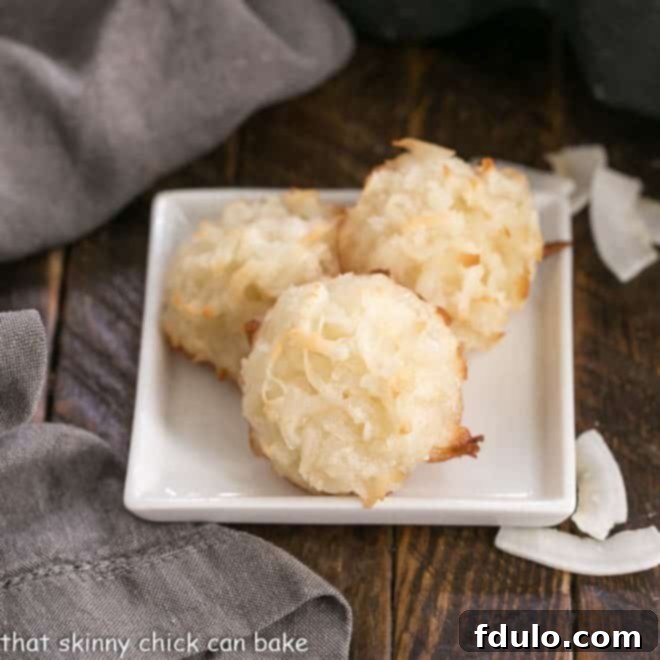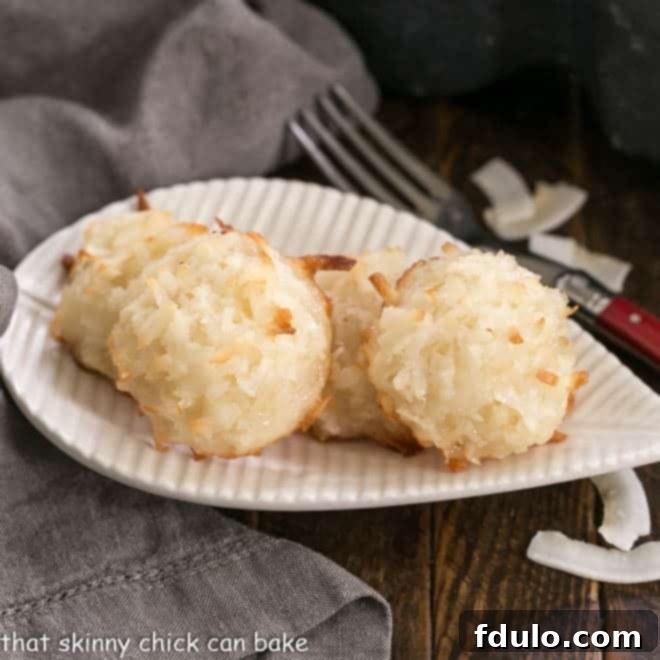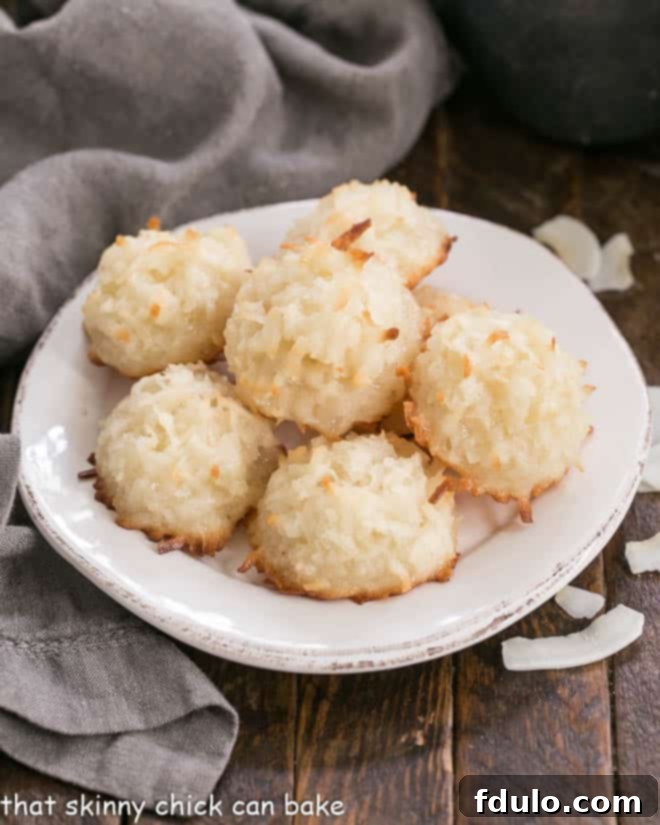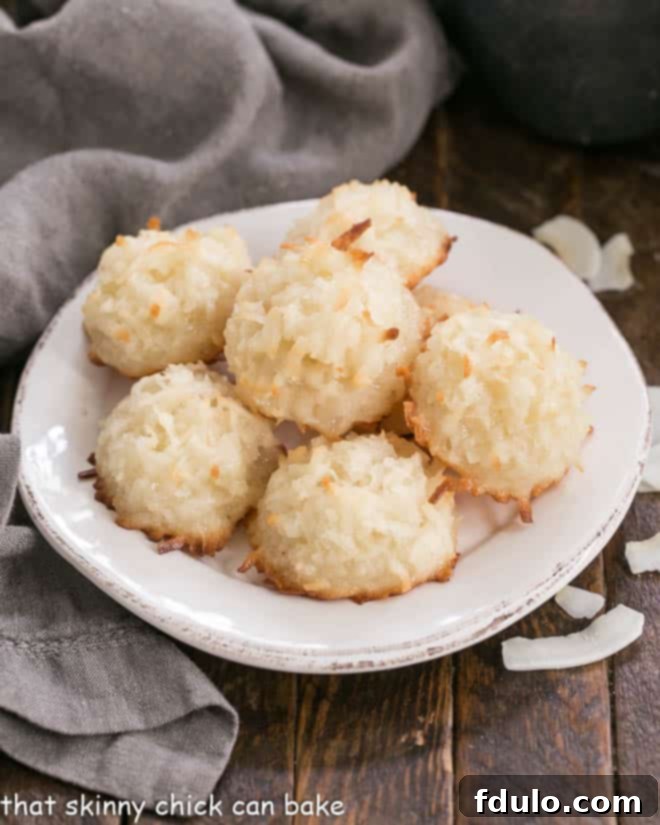Welcome, fellow dessert enthusiasts, to an exploration of one of the most delightfully simple yet incredibly satisfying sweet treats: the Classic Coconut Macaroon. This isn’t just any macaroon recipe; it’s the culmination of a quest for perfection, resulting in what we believe to be the absolute best macaroon recipe you’ll ever encounter. Imagine a cookie that’s wonderfully sweet, irresistibly chewy, with a perfectly toasted golden-brown exterior and a moist, tender interior bursting with rich coconut flavor. These cookies are not only an exquisite pairing for your afternoon tea but also make a stellar addition to any holiday cookie platter or a thoughtful homemade gift.
For a long time, Coconut Cookies held a special place in my heart, a passion unfortunately not fully shared by my family. This often meant my coconut cravings went unsatisfied or led to solo baking adventures. However, everything changed when I discovered a remarkable recipe by the renowned baking guru and cookbook author, Alice Medrich. Her approach to creating these classic treats revolutionized my perception of what a macaroon could be. The rave reviews from my friends, who declared them “spectacular,” cemented this recipe’s status as the gold standard in my kitchen for the Best Macaroon Recipe. It’s a testament to the fact that sometimes, the most authentic methods yield the most extraordinary results.

Why You Must Make This Classic Coconut Macaroon Recipe
In a world saturated with quick fixes and shortcuts, this recipe stands out for its commitment to classic techniques and unparalleled flavor. If you’re looking to elevate your baking game and truly impress, here are compelling reasons why this Classic Coconut Macaroon Recipe deserves a spot in your baking repertoire:
- Authored by Alice Medrich: When a recipe comes from Alice Medrich, you know it’s tried, tested, and guaranteed to deliver. Her deep understanding of baking science and her dedication to crafting exquisite desserts ensure that this macaroon recipe is nothing short of perfection. She’s famous for her meticulous approach and the incredible results her methods yield, making her a trusted name for both novice and experienced bakers. This particular recipe highlights her genius for transforming simple ingredients into something truly special.
- Perfectly Sweet and Chewy Perfection: These macaroons strike the ideal balance between sweetness and the natural flavor of coconut. The texture is a dream – wonderfully chewy on the inside, offering a satisfying bite, with a delicate crispness on the exterior that provides an intriguing contrast. Each bite melts in your mouth, leaving a lingering, delightful coconut essence. It’s the kind of texture that makes you reach for another, and another.
- A True Classic: Made Without Sweetened Condensed Milk: While many contemporary macaroon recipes opt for the convenience of sweetened condensed milk, this authentic version goes back to basics. It relies on a carefully balanced mixture of egg whites, sugar, and coconut, cooked gently over a double boiler. This traditional method, while requiring an extra step, is what imparts that signature chewy texture and allows the pure coconut flavor to shine through, unmasked by the cloying sweetness sometimes found in condensed milk versions. It’s the secret to an old-fashioned, deeply flavorful coconut cookie.
Understanding the Simple Ingredients for Perfect Macaroons
One of the beauties of these homemade coconut macaroons lies in their simplicity. You only need five basic ingredients to create these gourmet-level cookies. However, the quality of these ingredients and understanding their roles are key to achieving the perfect texture and flavor.
- Kitchen Staples: Sugar, Salt, Real Vanilla Extract – These foundational ingredients are critical. Granulated sugar provides the primary sweetness and contributes to the macaroon’s structure and golden color during baking. A pinch of salt is essential to balance the sweetness and enhance all the other flavors, preventing the cookies from tasting one-dimensional. As for vanilla, always opt for real vanilla extract. Its warm, aromatic notes elevate the overall flavor profile, adding a layer of sophistication that artificial vanilla simply cannot replicate.
- Egg Whites – The backbone of our macaroons! Egg whites are crucial for binding the ingredients and creating that characteristic chewy texture. For the easiest separation, begin with cold eggs. Cold yolks are firmer and less likely to break, making the separation process smoother and cleaner. Once separated, allow the egg whites to come to room temperature before mixing, as this helps them incorporate better and creates a more stable mixture. Don’t worry about the leftover yolks; they can be used for custards, hollandaise sauce, or even a rich crème brûlée!
- Sweetened Coconut (like Baker’s Angel Flake Coconut) – This is the star of the show! Sweetened shredded or flaked coconut provides both the bulk and the dominant flavor of these delightful cookies. Brands like Baker’s Angel Flake Coconut are ideal because their moisture content and level of sweetness are consistent, contributing to the perfect chewiness and rich taste. While unsweetened coconut can be used, you might need to slightly adjust the sugar content to achieve the desired sweetness, and the texture might be a touch drier. For that classic, moist, and chewy macaroon, sweetened coconut is truly the way to go.

Mastering the Art: Expert Tips for Flawless Classic Coconut Macaroons
If you’re accustomed to making a macaroon recipe with sweetened condensed milk, this classic method introduces an extra step involving a double boiler. I assure you, this additional effort is not just worth it; it’s transformative, yielding macaroons with unparalleled texture and depth of flavor that will make you a convert. Here are some invaluable tips to ensure your macaroons turn out spectacular every single time:
- PRO-Tip: The Double Boiler Method: The double boiler is key to gently heating the egg white and sugar mixture, dissolving the sugar crystals without scrambling the eggs. This creates a stable, slightly thickened base for your macaroons, which is crucial for their signature chewy texture. If you don’t own a double boiler, don’t fret! You can easily create a makeshift version by boiling a small amount of water in a saucepan and nestling a heatproof bowl (like a glass or stainless steel bowl) on top. The crucial detail here is that the bottom of the bowl should NOT touch the simmering water. The steam, not direct heat, is what gently cooks the mixture.
- Achieving the Right Consistency: While heating the mixture over the double boiler, it’s vital to stir it frequently. This ensures even cooking and prevents the egg whites from curdling. Continue stirring for about 5 minutes, or until the mixture visibly thickens and becomes opaque, losing its initial transparency. This change indicates that the sugar has fully dissolved and the egg whites have begun to stabilize, forming a sturdy foundation for your macaroons. Once opaque, remove the bowl from the heat and allow the mixture to cool. A cooling period of about 30 minutes is ideal; this allows the mixture to firm up slightly, making it much easier to scoop and preventing the macaroons from spreading too much during baking.
- Uniform Scooping for Even Baking: For beautifully uniform macaroons that bake evenly, use a cookie scoop to portion out the batter. A medium-sized cookie scoop (approximately 2 tablespoons) is perfect for creating classic-sized macaroons. Place the rounds of batter onto a parchment-lined baking sheet, ensuring they are spaced about 2 inches apart to allow for proper air circulation and slight expansion. Parchment paper is essential here to prevent sticking and ensure easy removal.
- The Two-Stage Baking Process: This recipe employs a brilliant two-stage baking temperature. You’ll start the macaroons at a higher oven temperature (350ºF) for the first 5 minutes. This initial burst of heat helps to set the exterior quickly, giving the macaroons a lovely golden crust and preventing them from spreading excessively. After this initial period, decrease the oven temperature to 325ºF and continue baking for another 10-15 minutes, or until the cookies are lightly browned with some darker, caramelized edges. This lower temperature allows the macaroons to cook through evenly, achieving that perfect chewy interior without over-baking the outside. Keep a close eye on them during the final minutes, as oven temperatures can vary.
Once you try this method, you will understand why I proclaim I will never make macaroons with a can of sweetened condensed milk again. This is truly the ultimate recipe. These chewy coconut macaroons are perfectly sweet, incredibly moist, and wonderfully chewy. They are just spectacular! I recall one of my local foodie friends, a connoisseur of all things baked, declaring these were the best macaroons she’d ever tasted – high praise indeed! So go ahead, all you coconut lovers out there, give this exceptional recipe a try. You won’t be disappointed.

Frequently Asked Questions About Coconut Macaroons
Proper storage is key to enjoying your delicious homemade macaroons for as long as possible. These delightful coconut cookies will maintain their freshness and chewy texture for up to a week when stored in an airtight container at room temperature. To extend their shelf life even further, you can store them in the refrigerator for up to two weeks. For longer storage, macaroons freeze exceptionally well! Simply place them in a single layer on a baking sheet to freeze solid, then transfer them to a freezer-safe bag or container, separating layers with parchment paper. They can be stored in the freezer for up to 3 months. When you’re ready to enjoy, just thaw them at room temperature for a few hours.
Encountering sticky macaroons can be a bit perplexing, but there are several common culprits. Firstly, high humidity in your storage environment can easily cause macaroons to absorb moisture and become sticky. Always store them in a cool, dry place. Other possibilities relate to the preparation and baking process: over-whipping the egg whites can sometimes lead to a slightly gummy texture, as too much air can disrupt the final consistency. More frequently, under-baking is the cause; if the macaroons don’t bake long enough, they won’t properly set, leading to a soft, sticky interior. Ensure they achieve that desirable golden-brown color and slightly crisp exterior. Don’t worry too much, though – even slightly sticky macaroons are almost always delicious and can still be enjoyed!
This is a common and understandable point of confusion, as the names are so similar! Despite their similar spellings, Macaroons and Macarons are two distinctly different types of cookies with unique origins, ingredients, and textures.
Macaroons (with the double “o”) are typically made with egg whites, sugar, and, crucially, coconut. Coconut is the defining ingredient; without it, it’s not a macaroon. Many versions are made with sweetened condensed milk for convenience, creating an easy and often very sweet cookie. However, to experience the true classic macaroon, as in this recipe, using egg whites and sugar without condensed milk yields a superior result. The texture of a macaroon is distinctively chewy, moist, and often somewhat rustic in appearance, with a delightful coconut flavor taking center stage.
Macarons (pronounced mah-kah-ROHN), on the other hand, are elegant French sandwich cookies. They are primarily made from almond flour (or almond meal), egg whites (often aged for best results), and granulated sugar. Macarons are characterized by their smooth, dome-shaped top, a delicate “foot” or ruffled edge around the base, and a crisp outer shell with a soft, slightly chewy interior. Unlike macaroons, which are almost exclusively coconut-flavored, macarons are incredibly versatile, coming in a vast array of colors and flavors for both the shells and their creamy fillings (ganache, buttercream, jam, etc.). Macarons are notoriously fussy to make, requiring precise measurements and careful technique, whereas macaroons are generally much simpler and more forgiving to bake. The resulting macarons are not chewy in the same dense way as macaroons but rather crisp and light, almost like a baked meringue.

Beyond Macaroons: More Coconut Delights and Cookie Inspiration
If you’re a true coconut aficionado or simply looking for more delightful treats to bake, here are some other fantastic recipes featuring coconut, alongside more general cookie inspirations:
- Banana Coconut Sweet Bread from Cravings of a Lunatic – A comforting and flavorful bread perfect for breakfast or a snack.
- Coconut Cream Pie – Indulge in a rich, creamy, and decadent dessert that celebrates coconut in all its glory.
- Coconut Truffles – Small, bite-sized balls of coconut bliss, often coated in chocolate.
- Chewy Coconut Cookies – For those who love the classic coconut flavor in a different cookie format.
- Coconut Cupcakes – Light, fluffy, and full of coconut goodness, these cupcakes are a crowd-pleaser.
- Chocolate Dipped Macaroons – Take your classic macaroons to the next level with a luxurious coating of melted chocolate.
- More Cookie Recipes – Explore a wide variety of other delicious cookie ideas for every occasion.
Stay in touch and share your baking adventures with us on social media! Find us on Instagram, Facebook, and Pinterest. Don’t forget to tag me when you try one of my recipes! If you love the results as much as we do, please consider giving this recipe a 5-star rating in the recipe card below. Your feedback and shares truly help us continue to create and share delicious recipes!

Classic Coconut Macaroons Recipe
15 minutes
30 minutes
45 minutes
16 cookies
This classic macaroon recipe from Alice Medrich is the best you’ll ever make! Experience perfectly chewy and sweet coconut macaroons, ideal for any occasion.
Ingredients
- 4 large egg whites
- 3 cups sweetened shredded coconut (such as Baker’s Angel Flake)
- ¾ cup granulated sugar
- 2 teaspoons pure vanilla extract
- ¼ teaspoon fine sea salt
Instructions
- Preheat your oven to 350ºF (175ºC).
- Line two large baking sheets with parchment paper to prevent sticking. Set them aside.
- Prepare a double boiler: Fill a large skillet or saucepan halfway with water and bring it to a gentle simmer. In a heatproof bowl that fits snugly over the skillet without touching the water, combine all your ingredients: egg whites, sweetened coconut, sugar, vanilla extract, and salt. Place the bowl into the skillet.
- Cook the mixture, stirring frequently with a spatula or wooden spoon for about 5 minutes, until it visibly thickens and becomes opaque (no longer translucent). This process gently dissolves the sugar and slightly cooks the egg whites.
- Carefully remove the bowl from the water bath and let the coconut mixture cool for approximately 30 minutes. This cooling period helps the mixture firm up, making it easier to handle and scoop.
- Using a medium cookie scoop (about 2 tablespoons), scoop out portions of the batter and place them about 2 inches apart onto the prepared parchment-lined baking sheets.
- Bake for the first 5 minutes at 350ºF (175ºC). After 5 minutes, decrease the oven temperature to 325ºF (160ºC) and continue to bake for an additional 10-15 minutes, or until the macaroons are lightly golden brown with slightly darker, toasted edges.
Notes
Eggs separate best when they are cold, as the yolk is less likely to break. For optimal results, ensure your egg whites are at room temperature before combining with other ingredients, as this helps them incorporate more smoothly into the mixture.
For an extra treat, once the macaroons have cooled, you can dip their bases in melted dark or milk chocolate. Allow the chocolate to set on parchment paper before serving.
Recommended Products for Baking
As an Amazon Associate and member of other affiliate programs, I earn from qualifying purchases.
- OXO Good Grips Medium Cookie Scoop
- Reynolds Kitchens Non-Stick Baking Parchment Paper Sheets – 12×16 Inch, 22 Count
- USA Pan Bakeware Half Sheet Pan
Nutrition Information:
Yield:
16
Serving Size:
1 cookie
Amount Per Serving:
Calories: 115Total Fat: 4gSaturated Fat: 4gTrans Fat: 0gUnsaturated Fat: 0gCholesterol: 0mgSodium: 92mgCarbohydrates: 18gFiber: 2gSugar: 15gProtein: 1g
HOW MUCH DID YOU LOVE THIS RECIPE?
Please leave a comment on the blog or share a photo on Pinterest
